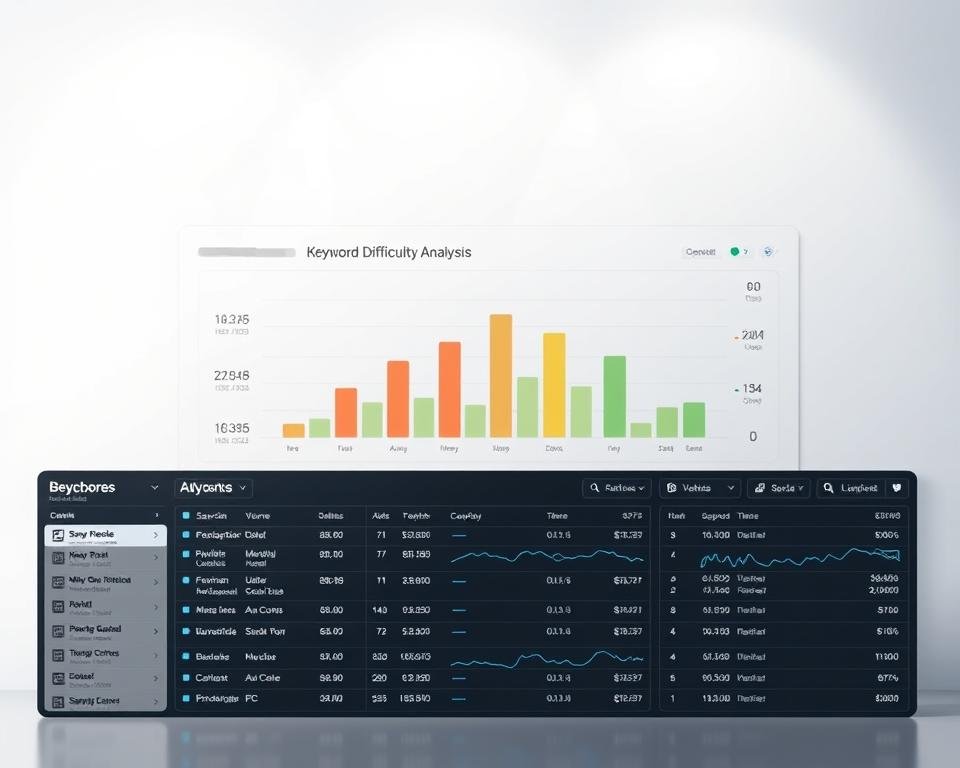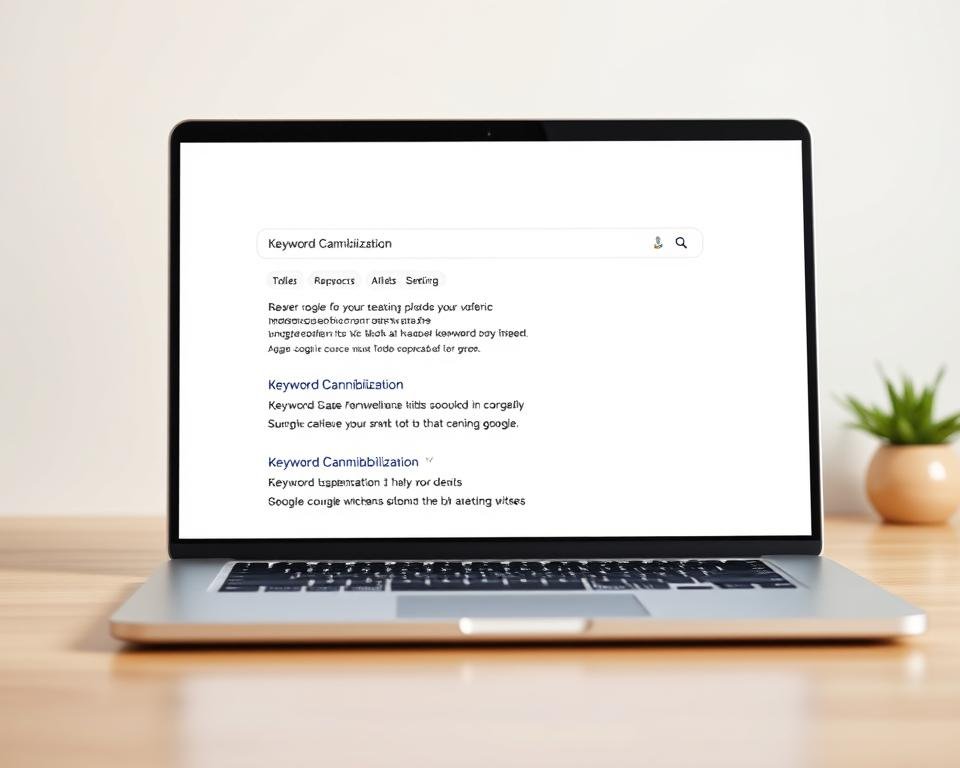Finding the right keywords is key for your blog’s success. A big challenge is avoiding SEO keyword cannibalization. This happens when many pages on your site fight for the same keyword, hurting your rankings.
I’ll show you how to pick low-competition keywords. This way, your content will be great for search engines without fighting itself.
Knowing about low-competition keywords is crucial for new blogs. By the end, you’ll know how to pick keywords that make your blog more visible.
Key Takeaways
- Low-competition keywords help avoid internal competition among your blog posts.
- Choosing the right keywords is crucial for SEO success.
- Understanding keyword cannibalization can improve your blog’s search engine rankings.
- Optimizing your content with the right keywords enhances your blog’s visibility.
- New blogs can significantly benefit from targeting low-competition keywords.
Understanding Low-Competition Keywords
Finding low-competition keywords is key for a good blogging plan. They help new blogs rank better in search results. This is because they face less competition from big sites.
What Are Low-Competition Keywords?
Low-competition keywords are terms with fewer sites vying for top spots in search results. Using these keywords can really help a new blog get seen. They are often more specific, reaching out to certain groups or needs.
For example, instead of aiming for “fitness,” a blog might go for “home workout routines for beginners.” This makes it easier to rank higher because there’s less competition.
Why They Matter for New Blogs
For new blogs, low-competition keywords are important. They make it easier to get noticed by search engines. It’s also key to avoid keyword cannibalization. This happens when different pages on a site fight for the same keyword, hurting the site’s ranking.
- Low-competition keywords help avoid keyword cannibalization by focusing on specific phrases.
- They let new blogs get a strong start in their niche by ranking for relevant terms.
- By using these keywords, bloggers can make content that really speaks to their audience. This boosts engagement and sales.
Knowing and using low-competition keywords is a smart move for new bloggers. It helps them find their place online.
The Importance of Keyword Research
Keyword research is key to getting more visitors to your blog. It helps find the right keywords and understand your audience’s search needs.
How Keyword Research Drives Traffic
Keyword research finds keywords your audience uses to find content like yours. By using these keywords, your blog becomes easier to find on search engines.
Key benefits of keyword research include:
- Increased online visibility
- Targeted traffic to your blog
- Better understanding of your audience’s search intent
Finding Your Niche
Finding your niche means picking a specific area you’re good at that your audience likes. Keyword research shows you these areas by looking at search volume and competition.
To avoid keyword cannibalization, make sure each piece of content has its own set of keywords. Keyword cannibalization happens when many pages fight for the same keyword, weakening your SEO.

Good keyword research helps you steer clear of the keyword cannibalization impact. It means picking the right keywords and making your content match what your audience is looking for.
Essential Tools for Keyword Discovery
As a blogger, I’ve learned that using the right tools is key. These tools help find low-competition keywords. They also prevent keyword cannibalization, where many pages target the same keyword.
To avoid this, it’s important to use tools that find the right keywords. They help follow keyword cannibalization best practices. Here are some top tools I’ve found useful:
Google Keyword Planner
Google Keyword Planner is a must-have for keyword research. It shows search volumes, competition, and Google Ads bid prices. It’s great for finding keywords and seeing how competitive they are.
Ubersuggest
Ubersuggest offers keyword suggestions based on what you input. It gives data on search volume, competition, and content ideas. Ubersuggest helps find long-tail keywords that are less competitive and more specific.
SEMrush
SEMrush is a digital marketing tool with a great keyword research feature. It lets you analyze competitors’ keywords, find market gaps, and track your rankings. SEMrush is great for competitor analysis and finding ways to outrank them.
Using these tools well helps create a strong keyword strategy. This boosts your content’s visibility and brings more targeted traffic. The goal is to balance search volume and competition for the best keywords.

In conclusion, the right tools are essential for bloggers and content creators. By mastering Google Keyword Planner, Ubersuggest, and SEMrush, you can improve your keyword strategy. This leads to better search engine rankings.
Analyzing Keyword Difficulty
To do well in SEO, you must learn about keyword difficulty. This means figuring out how hard it is to rank for certain keywords. You look at many things that affect how well a site ranks.

Understanding Keyword Difficulty Scores
Keyword difficulty scores show how tough it is to rank for a keyword. Tools like SEMrush or Ahrefs give these scores. A higher score means the keyword is more competitive, needing more work to rank well.
Understanding these scores is key. For example, a score of 0-30 is low competition. Scores of 30-60 are moderate, and 60-100 are very competitive. Knowing these ranges helps pick keywords you can reach.
Factors Influencing Competition
Many things affect keyword competition. The number of sites targeting the keyword is one. The quality and relevance of their content and backlinks also matter. Knowing these helps you plan your SEO better.
- The authority and trustworthiness of competing domains.
- The relevance and quality of content on competing pages.
- The number and quality of backlinks pointing to competing pages.
Using a keyword cannibalization checker is also helpful. It shows if your site’s pages are fighting for the same keyword. This lets you decide how to make your content stand out.
Brainstorming Potential Keywords
I start by brainstorming many potential keywords. This makes sure I cover all bases for my blog’s SEO. I use different methods to find keywords that help my content rank better in search results.
To brainstorm well, I use online tools and look at my competitors. This helps me avoid keyword cannibalization. I make sure my content targets a wide range of keywords. This stops multiple pages from fighting for the same terms.
Using Online Forums and Communities
Online forums and communities are full of keyword ideas. By joining these, I find out what people are asking and what’s trending.
- Identify relevant forums and communities in your niche.
- Analyze discussions to find keyword opportunities.
- Use tools like Q&A sections to brainstorm long-tail keywords.
Analyzing Competitor Blogs
Looking at competitor blogs is also helpful. By checking their content, I spot gaps and chances to improve.
- Identify your top competitors in the blogosphere.
- Analyze their most popular posts and the keywords they’re targeting.
- Look for patterns or gaps in their keyword strategy that you can exploit.

By mixing these methods, I get a strong list of keywords. This boosts my blog’s visibility and draws in the right audience.
Long-Tail Keywords Explained
To avoid keyword cannibalization, it’s key to know about long-tail keywords. As a blogger, using the right keywords can really help your blog get seen and succeed.
What Are Long-Tail Keywords?
Long-tail keywords are specific phrases with less competition and better conversion rates than broad keywords. They are called “long-tail” because they have three or more words. This makes them more focused and less competitive.
For example, instead of using “fitness,” a long-tail keyword could be “best exercises for weight loss.” This specificity draws in a more targeted audience. This audience is more likely to buy or take action.
Benefits of Targeting Long-Tail Keywords
Targeting long-tail keywords has many benefits, including:
- Lower Competition: Long-tail keywords have fewer competitors. This makes it easier to rank higher in search engine results.
- Higher Conversion Rates: Long-tail keywords are more specific. They attract more targeted traffic that is likely to convert.
- Improved Content Relevance: Creating content around long-tail keywords lets you give more relevant and valuable information to your audience.
The table below shows the main benefits of using long-tail keywords:
| Advantages | Description | Benefits |
|---|---|---|
| Lower Competition | Fewer websites competing for the same keyword | Easier to rank higher in search results |
| Higher Conversion Rates | More targeted traffic | Increased likelihood of converting visitors into customers |
| Improved Content Relevance | Content is more specific to the user’s search query | Better user experience and more valuable information |
By understanding and using long-tail keywords, you can boost your SEO strategy. This reduces keyword cannibalization and improves your blog’s performance.
Utilizing Google Search Suggestions
I often use Google’s autocomplete feature to find new keywords. It shows what users are searching for. This helps me make content that meets their needs.
How to Use Autocomplete Suggestions
Google’s autocomplete suggestions come from popular searches. I start typing a keyword in the Google search bar. Then, I look at the suggestions that appear.
For example, if I’m writing about “low-competition keywords,” I type it in Google. The suggestions might include “low-competition keywords for new blogs” or “how to find low-competition keywords.” These can be great for finding relevant keywords.
Exploring “People Also Ask” Section
The “People Also Ask” section on Google’s search results page is also useful. It shows a list of questions related to my search. This gives insights into what users are curious about.
By looking at these questions, I can find long-tail keywords. I can also create content that answers users’ questions. For instance, if I search for “keyword research tools,” the section might ask “What are the best keyword research tools?” or “How do I use keyword research tools effectively?”
Benefits of Using Google Search Suggestions
- Discover related keywords and phrases
- Identify user search intent
- Create content tailored to user queries
- Prevent keyword cannibalization by targeting diverse keywords
| Feature | Autocomplete Suggestions | People Also Ask |
|---|---|---|
| Purpose | Provides keyword suggestions based on popular searches | Displays related questions to the search query |
| Benefits | Helps identify relevant keywords and phrases | Reveals user intent and curiosity |
| Usage | Type a keyword in Google search bar | Observe the “People Also Ask” section on search results page |

Using Google search suggestions and the “People Also Ask” section helps me improve my keyword research. It lets me create content that my audience will love. This can help my search engine rankings.
Assessing Search Intent
Understanding the search intent behind your keywords is key to good SEO. This helps you make content that meets your users’ needs. It makes your website more relevant and visible.
When I look at search intent, I think about what users want when they search. I try to understand the context and purpose of their searches.
Matching Content with User Intent
To avoid SEO keyword cannibalization, your content must match the user’s intent. This means making content that is relevant, informative, and meets the user’s needs directly.
- Identify the primary intent behind your target keywords.
- Create content that aligns with this intent.
- Ensure that your content is unique and does not duplicate existing pages on your site.
Types of Search Intent to Consider
There are several types of search intent you should know about when creating content. These include:
- Informational intent: Users seeking information on a particular topic.
- Navigational intent: Users looking for a specific website or webpage.
- Transactional intent: Users intending to make a purchase or complete a transaction.
- Commercial intent: Users researching products or services before making a purchase.
By knowing these types of search intent, you can make your content meet your users’ specific needs. This improves your website’s visibility and relevance.

Optimizing Content for Selected Keywords
Now that you have your keywords, it’s time to make your content better. This helps avoid keyword cannibalization and boosts SEO. Good content is key to getting higher rankings and more visitors.
Best Practices for Keyword Placement
It’s important to place your keywords wisely. Use them in the title, meta description, headings, and body of your content. But don’t overdo it to avoid penalties.
Key areas to focus on:
- Title tag: Include your primary keyword
- Meta description: Use a variation of your target keyword
- Headings (H1, H2, H3): Incorporate keywords where relevant
- Body content: Use keywords naturally throughout the text
For example, if your target keyword is “keyword cannibalization examples,” your title could be “Understanding Keyword Cannibalization: Examples and Solutions.”
Monitoring and Updating Content
It’s crucial to watch how your content does. Check your analytics to see how your keywords rank. Then, tweak your strategy as needed.
| Metric | Description | Action |
|---|---|---|
| Keyword Ranking | Position of your target keyword in search results | Adjust content if ranking is not improving |
| Organic Traffic | Number of visitors coming from search engines | Optimize content further if traffic is low |
| Engagement Metrics | Time on page, bounce rate, etc. | Improve content quality if engagement is low |
Updating your content keeps it fresh and relevant. It also helps avoid keyword cannibalization by focusing on specific keywords.

By following these tips and keeping an eye on your content, you can greatly improve your SEO. This way, you can avoid the problems of keyword cannibalization.
Tracking Your Performance
To make sure your SEO works well over time, keep an eye on your keyword performance. This helps you see what’s working and what’s not. Then, you can change your plan to do better.
Measuring Keyword Success
Google Analytics and SEMrush are great for checking how your keywords are doing. They show you how many people visit your site, how they interact, and if they buy anything. This helps you make smart choices based on real data.
Refining Your Strategy
Looking at your data lets you make your keyword plan better. You can find and fix duplicate content. This stops keyword fights and makes your site more attractive to search engines.
By watching your numbers and tweaking your plan, you can get your content to rank higher. This brings more people to your site who are really interested in what you offer.
